

Anyone familiar with the judicial systems knows that a Court Reporter is essential. Various forms of court reporting go back thousands of years and have always been an integral part of the legal system. It has evolved from innovation and technological advances, but where did it begin?
63 B.C.
Court reporting can be traced back to Marcus Tullius Tiro, who worked for Roman philosopher and lawyer Cicero. He took dictation and managed Cicero’s financial matters. To transcribe speeches, he developed a system of notation symbols and abbreviations. It became a shorthand system consisting of over 4,000 signs. This notation system became known as Tironian notes and was later taught in European monasteries during the Medieval period. The notes eventually expanded to over 13,000 signs, but its use declined after 1100 A.D.
_____________________________________
1180
John of Tibury, a monk created the first shorthand system for English speakers. Shorthand was not widely used by English speakers until British physician Dr. Timothie Bright published a system of 500 symbols to be used as English shorthand which became popular with scholars and ministers.
_____________________________________
1602
John Willis published a shorthand system based on the English alphabet, rather than symbols.
_____________________________________
1772
Thomas Gurney appointed the first official shorthand writer of the English government. He was one of several people who developed English alphabet shorthand systems.
_____________________________________
1837
Isaac Pitman created a shorthand system based on phonetics. It was used for decades and after numerous refinements became the pre-eminent system among England’s court reporters. It is still the most used system in England and its former categories.
_____________________________________
1877
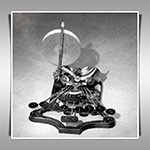
American Court Reporter Miles Bartholomew invented the first American shorthand machine, revolutionizing the industry and rendering the pen somewhat obsolete in court reporting. It gave Court reporters the tool they needed to type faster than they can write, making pens almost unnecessary for shorthand. Ten keys could be depressed at once to create a series of dots and dashes (like Morse code). He soon became known as the “Father of the Stenograph.”
_____________________________________
1889
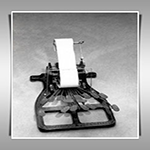
George Kerr Anderson developed the first keyboard to allow two or more of its keys to be pressed at the same time. This typewriter used English characters instead of code, allowing words and symbols to be written.
_____________________________________
1893
The first American version of John Robert Gregg’s shorthand system was published. It was a newly devised system based on the use of cursive rather than geometric symbols. It soon replaced Pitman’s system. It became well-known in the business world as the standard method most court reporters and secretaries used when taking dictation.
_____________________________________
1906
Ward Stone Ireland invented a more sophisticated steno machine to record speech with high-speed keyboard with a minimal number of keys, a design concept that is still used today. Adding recording devices made for a more efficient and accurate method.
_____________________________________
1909
America’s first national Speed Contest for shorthand. It was organized by the National Court Reporters Association (NCRA).
_____________________________________
1910
Stenotype machine introduced into the US court system.
_____________________________________
1911
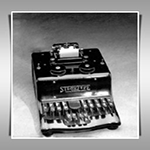
First stenograph with a totally depressible keyboard. Gave reporters the ability to write numbers and words phonetically with fewer strokes. This machine is 40 pounds lighter than its predecessor.
_____________________________________
1914
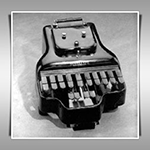
The weight of stenotype machines became lighter. A manufacturer in Ireland created the Master Model Stenograph which was only 6 pounds instead of 11.
_____________________________________
1922
American Nathan Behrin achieves world record of 350 words per minute during a two-minute test using the Pitman system.
_____________________________________
1927
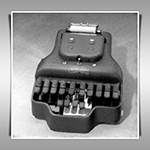
The LaSalle Stenotype, made with Ireland tools, became known as the “Master Model Four.” It used a two-spool ribbon system. The Great Depression cut its life short, and the court reporting profession also slowed down until the end of the 1930’s.
_____________________________________
1939
Robert Wright refined the Ireland write and came up with a single 11-inch ribbon that held 100 folds of paper. Known for being dependable and quiet, it became a standard for court reporters and secretaries alike.
_____________________________________
1940s
Stenotype machines had changed the very definition of the word “shorthand” to include the typed abbreviations.
_____________________________________
1963
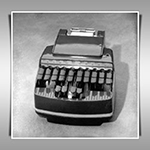
The Stenograph Data Writer had organ-type switches with good contact and transmission with minimum key pressure. It utilized magnetic tape with machine notes for computer transcription. The first model had a cable that connected it to a separate tape recorder.
_____________________________________
1970
The Stenograph Data Writer was updated to a cartridge.
_____________________________________
1974
The Stenograph Data Writer replaced the cartridge with a cassette.
_____________________________________
1975
Registered Professional Reporter designation goes into effect, dividing NCRA’s membership into two classifications: Professional (known as “Registered” today) or Participating Reporters.
_____________________________________
1982
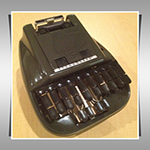
First Stenograph Machine to have a plastic shell or casing, which made the machine more durable.
_____________________________________
1987
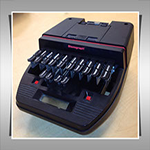
The first machine was released that allowed steno notes to be transferred to a floppy disc and translated on a computer.
_____________________________________
1992
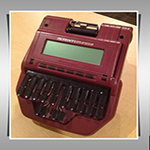
The Stentura was developed, which had the first of its kind LCD screen that could display steno or translated notes into English. As technology continued to improve, more and more Court Reporters ditched their paper notes in favor of machines that would sync to their computers and allow them to write cleaner and produce transcripts much faster than translating paper notes into a typewriter.
_____________________________________
2005
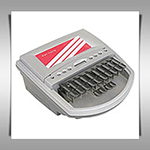
Marked the beginning of technology that would allow attorneys to connect into a reporters feed to view Real Time Streaming. Stentura rolled out professional and affordable student-version machines featuring USB and serial connectivity as well as optional wireless real-time.
_____________________________________
2006
Technological advancements continued with the ability to function paperless or with paper, and compatibility with SD (Secure Digital) cards, recording live testimony, USB and DB9 ports.
_____________________________________
2009
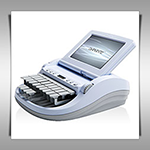
Monumental advances were made in speed and accuracy with the launch of the Diamante writer. Weighing only 4.5 pounds, it offered two SD cards, two USB ports, and microphone and headset jacks for AudioSync; and optional Bluetooth or Wi-Fi real-time translations.
_____________________________________
2015
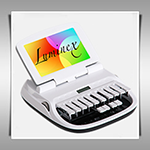
The launch of the Luminex featured more precision in addition to smaller size and lighter weight and touch.
_____________________________________
2020
With the COVID-19 pandemic came the embracement of remote technology overnight. Less depositions were conducted in-person – more via remote and hybrid instead. Court Reporters thereby traveled less and leverage technologies that created more accurate transcripts in less time.
Sources:
https://www.stenograph.com/history-writers-3
https://vtestify.com/2022/02/10/court-reporting-technology-through-history/
https://www.muirreportinggroup.com/history.htm
https://www.naegeliusa.com/blog/the-evolution-and-history-of-court-reporting
https://envision.legal/history-of-the-stenograph/







